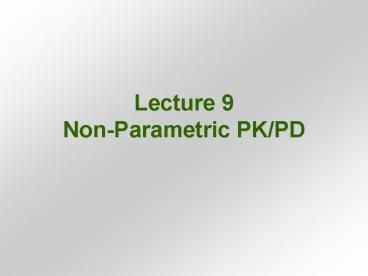Lecture 9 NonParametric PKPD - PowerPoint PPT Presentation
1 / 44
Title:
Lecture 9 NonParametric PKPD
Description:
Each of these boluses is then treated to the usual 'disposition' of drug: ... We can generalize the PK function as a 'unit disposition function' ... – PowerPoint PPT presentation
Number of Views:262
Avg rating:3.0/5.0
Title: Lecture 9 NonParametric PKPD
1
Lecture 9Non-Parametric PK/PD
2
"NON-PARAMETRIC" APPROACH
SEMI-PARAMETRIC" APPROACH
3
Fundamental Assumption
Connecting the observed concentrations captures
the shape of the PK vs. time curve
4
2. Curve Representation Smoothing
2.1. Goal Curve that looks like "perfect"
data Dilemma If follow data too closely, may
believe noise (large variance) If smooth too
much (e.g., to straight line), may ignore signal
(large local bias).
5
General Concept Convolution
- In linear systems theory, you can take any
input and decompose it into a series of boluses
6
General Concept Convolution
- Each of these boluses is then treated to the
usual disposition of drug
7
General Concept Convolution
- You then add up all of the concentrations that
resulted from each bolus to get the overall
profile
This is really just a statement of the
superposition principle
8
Consider an input with two boluses
- A bolus is given at 0 and 5 minutes
- The resulting concentration is the sum of the
response to each bolus
9
We can generalize the PK function as a unit
disposition function
- The fate of a unit of drug injected into the
system as a bolus - e.g.,
- More generally, we can call the fate of a unit
function the UDF(t) - Engineers will recognizes this as the IRF or
impulse response function - When you estimate PK, you are estimating the
parameters of the UDF
10
We can write for anyseries of N boluses
11
The input function I(t)
- Let I(t) be the amount of a bolus at time t, with
a time resolution of 1 second - We can then generalize the prior equation as
12
The Convolution Integral
- To make this smooth, rather than have a bolus
every second, we can treat the input as a
continuous function - Or, more generally
- This is what you have been doing in all the
linear PK analysis
13
I(t) can be any function
14
D(t) can be any non-saturable function
15
Usual Simulation Problem isConvolution
- Calculate Cp(t) given I(t), D(t)
16
However, the typical PK estimation problem is
actually DEconvolution
- Given Cp(t) and I(t), calculate D(t) (i.e.,
calculate the parameters of the UDF
17
Controlled release problems are also DEconvolution
- Given Cp(t) and D(t), calculate I(t) (i.e.,
calculate the release rate to give the desired PK
profile
18
"NONPARAMETRIC" PK/PD
Apply nonparametric methods to exploratory
analysis of PK/PD data.
19
Typical experiment showing hysteresis
20
Add an effect site
21
Add an effect site
Input
22
Add an effect site
Disposition
23
For the Effect Site
I(t
)
The input is the plasma concentration over time
24
For the Effect Site
The disposition function is the first order delay
25
So, non-parametric PK/PD meansfitting ke0 so
that
So, how do you do this?
26
Various Approaches
Divide it into infusions
Divide it into polygons connect the dots
Approximate data using splines, local linear
regression to exponential functions, smoothing
functions, etc
27
Once you know Ce, then fitCe to Effect
- Standard models Sigmoidal, Biphasic, power,
linear, etc. - Or, use no model at all just graph out the
relationship!
28
How to implement a simpleconnect-the-dots
- Use linear when function is increasing
- Use log-linear when function is decreasing
29
Connect the dotsIncreasing concentrations
Compute Ce(t) as convolution of above with
30
Connect the dotsDecreasing concentrations
Compute Ce(t) as convolution of above with
31
Connect the dotsEasy to implement
- Excel example
- NONMEM Example
- Direct collapse the hysteresis loop
- ke0obj.exe
- Enter time CP data pairs
- Enter time effect data pairs
- Estimates keo that minimizes the area within the
hysteresis loop
32
Excel Example
33
NONMEM Code
INPUT ID TIME EFFDV CP PRED E0THETA(1)
Baseline
EMAXTHETA(2) Max Effect
C50THETA(3)EXP(ETA(1)) C50, only parameter
with interindividual variability GAMTHETA(4)
Gamma - don't add an ETA
to this - very hard to fit KE0THETA(5)EXP(ETA
(2)) Ke0 IF (TIME.EQ.0) THEN CE, PTIME, PCP,
PCE 0 DT1TIME-PTIME IF(CP.GE.PCP) THEN
SLOPE (CP-PCP)/DT1 DELTADT1SLOPE(KE0PCP-S
LOPE)(1-EXP(-KE0DT1))/KE0 ELSE SLOPE
(LOG(CP)-LOG(PCP))/DT1 DELTAPCPKE0/(KE0SLOPE
)(EXP(DT1SLOPE)-EXP(-KE0DT1)) ENDIF CE
PCEEXP(-KE0DT)DELTA Full sigmoidal Emax PD
model with simple additive error Y
E0(EMAX-E0)CEGAM/(CEGAMC50GAM)
EPS(1) Variables for NONMEM to remember at the
next iteration PTIME TIME Prior Time PCP CP
Prior plasma concentration PCE CE
Prior effect site concentration
34
ExamplePropofol and EEG
100
100
80
80
60
60
40
40
E
A
20
20
0
0
0
10
20
30
40
50
Time
Ce first attempt
35
ExamplePropofol and EEG
Time
Ce revised model
36
Main Caveat
- You must have a reasonable idea of the shape of
the concentration vs. time curve
37
You are given these data to fit
38
But it was actually a study with target
controlled IV drug delivery
39
Key Points aboutNonparametric PK/PD
- If you know Cp(t) and effect(t), you can estimate
keo and Ce(t) - Assumes the equilibration between the plasma and
the effect site is first order - Assumes that the relationship between Ce and
effect is independent of time, and dose - Need reasonably high resolution measures of
concentration and effect - Enough to connect the dots
- Makes no assumptions about the shape of either
the PK model or the PD model
40
(No Transcript)
41
PowerPoint Files
- Go to anesthesia.stanford.edu, then navigate to
online lectures, then to Advanced PK/PD for - These lecture notes
- Excel spreadsheet example
- NONMEM PRED routine
- ke0obj.c and ke0obj.exe
42
(No Transcript)
43
(No Transcript)
44
PowerPoint Files
- Go to anesthesia.stanford.edu, then navigate to
online lectures, then to Advanced PK/PD for - These lecture notes
- Excel spreadsheet example
- NONMEM PRED routine
- ke0obj.c and ke0obj.exe































